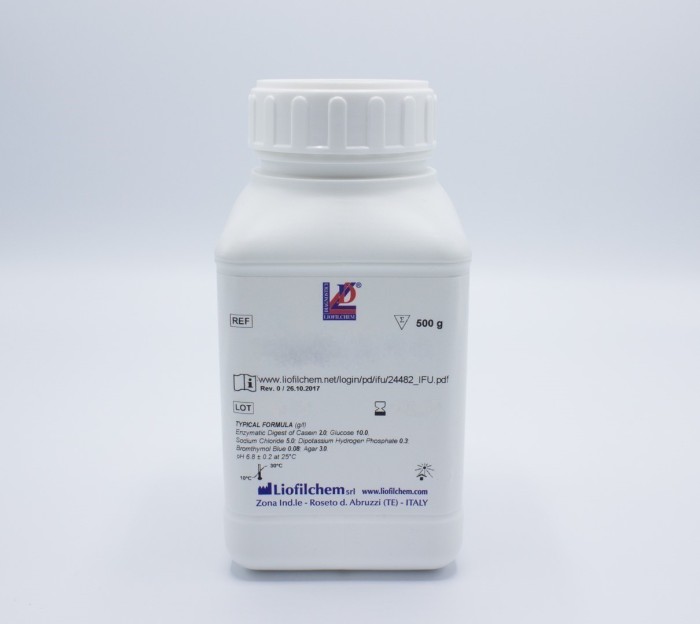Specifications:
| Application | Microbiology | ||
| Storage Temperature | Ambient | ||
| Product Type | Culture Medium | Forms | Powder |
| Product Brand | Liofilchem | ||
| Product Grade | Microbiology grade | ||
Liofilchem® Barnes Agar Base is a selective basal medium specifically formulated for the isolation and presumptive identification of fecal streptococci. This medium is highly effective in differentiating various group D streptococci and supports selective growth while inhibiting other bacterial contaminants. The incorporation of Triphenyl-tetrazolium Chloride (TTC) enhances the visualization of colonies through color differentiation.
Composition:
The medium contains the following components (per liter):
- Tryptone: 10.0 g (Provides nitrogen, amino acids, and essential nutrients for bacterial growth)
- Yeast Extract: 10.0 g (Supplies B-group vitamins and other growth factors)
- Thallium Acetate: 1.0 g (Selective agent to inhibit Gram-positive bacteria, excluding group D streptococci)
- Dextrose Anhydrous: 10.0 g (Fermentable carbohydrate providing energy)
- Agar: 14.0 g (Solidifying agent)
- Final pH: 6.0 ± 0.2 at 25°C
Key Features:
- Selective Properties: Thallium acetate ensures selective growth of fecal streptococci by inhibiting Gram-positive bacteria not belonging to group D.
- Differentiation of Streptococci: The addition of TTC allows visualization of group D streptococci colonies with distinctive color patterns.
- Broad Applications: Suitable for clinical, food, and environmental microbiology to isolate and identify fecal contamination.
- Ease of Preparation: No complex preparation steps, ensuring easy and consistent use in the laboratory.
Applications:
- Clinical Microbiology:
- Identification of group D streptococci in clinical samples for presumptive diagnosis.
- Food Safety:
- Detection and quantification of fecal streptococci in food products, ensuring compliance with safety regulations.
- Environmental Testing:
- Monitoring water quality and detecting fecal contamination in wastewater and surface water.
Preparation Instructions:
- Rehydration:
- Suspend 45.0 g of powder in 990 ml of distilled or deionized water.
- Heat and gently agitate until the medium is completely dissolved.
- Sterilization:
- Autoclave at 118°C for 15 minutes.
- Supplementation:
- Cool the sterilized medium to 45-50°C.
- Aseptically add 10 ml of TTC 1% supplement (Catalog Code: 80300) and mix thoroughly.
- Dispensing:
- Dispense the prepared medium into sterile Petri dishes.
Test Procedure:
- Inoculation:
- Apply the sample, either undiluted or diluted, directly to the surface of the prepared plates.
- Incubation:
- Incubate the plates at 36 ± 1°C for 24 hours in an aerobic atmosphere.
- Observation:
- Observe the colony morphology:
- White or light pink colonies: Enterococcus faecium and Enterococcus bovis.
- Dark red-centered colonies with a white ring: Enterococcus faecalis.
- Uniformly red colonies: Streptococcus lactis and other group N species.
- Observe the colony morphology:
Results Interpretation:
- Examine colonies for growth and distinctive coloration patterns as described above.
- For confirmation, perform additional biochemical or serological tests to identify specific streptococci species.
Quality Control:
- Dehydrated Medium:
- Appearance: Homogeneous, light beige powder.
- Prepared Medium:
- Appearance: Clear, light amber.
- Expected Microbial Results:
- Enterococcus faecalis ATCC 19433: Good growth with red colonies.
- Escherichia coli ATCC 25922: Inhibited.
- Streptococcus pyogenes ATCC 19615: Inhibited.
- Staphylococcus aureus ATCC 25923: Inhibited.
Storage and Shelf Life:
- Dehydrated Medium:
- Store at 10-30°C, away from light, in the original tightly sealed container.
- Valid for 2 years from the date of manufacture.
- Prepared Medium:
- Store at 2-8°C, protected from light.
- Do not use the product beyond the expiry date or if there are signs of contamination or deterioration.
Performance and Limitations:
- Some strains of streptococci may require additional tests for definitive identification.
- Colony morphology can vary slightly between strains; use supplemental tests for confirmation.
- Overheating during preparation may reduce medium performance.
Safety Information:
- Designed for in vitro diagnostic use.
- Not classified as hazardous under current regulations.
- Operators must be trained in microbiological techniques.
- Follow local regulations for waste disposal.
Presentation:
- Dehydrated Medium:
- 500 g (Catalog Code: 610156)
References:
- Barnes, E. M. (1956). "Methods for the isolation of fecal streptococci from bacon factories." J. Appl. Bacteriol. 19:193-203.
- Barnes, E. M. (1956). "Tetrazolium reduction as a means of differentiating Streptococcus faecalis from Streptococcus faecium." J. Gen. Microbiol. 14:57-68.
- ICMSF. (1978). "Microorganisms in foods 1: Their significance and methods of enumeration." 2nd ed.




 0
0
